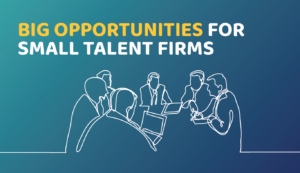Opportunities for Contingent Workforce Strategies
Staffing and recruiting firms have historically focused on helping clients fill permanent and temporary roles. This focus largely continues today, despite the massive disruptions to workforce composition via the pandemic and the Great Resignation.
Contingent and contract workers continue to make up an ever-growing portion of the global workforce. By not developing their offerings, some agencies are missing out on one of the biggest opportunities for growth in this new era of staffing and recruiting.
The New Talent Landscape
New technologies, emerging industries, changes in worker preferences, and the pandemic all factor into the current transition away from conventional work models towards non-traditional. As of 2021, contingent workers made up nearly one-third of the entire US workforce. Nearly 60% of those workers were considered Independent Contractors (ICs).
Whether they call themselves contractors, freelancers, or gig workers, a clear trend is being established early in this decade: more people are seeking to work for themselves. This trend of escaping traditional working models that may have offered low wages or limited flexibility, or poor work-life balance has broad implications for contingent workforce dynamics.
The shift towards contract work is not necessarily bad news for employers. But staffing and recruiting agencies now need to consider how they can better connect their clients to this growing class of talent. There are many benefits agencies can provide their clients by adapting to this new talent landscape including:
- Access to a global talent pool
- Staffing flexibility
- Reduced training expenses
- Lower costs on office supplies and space
- Increased workforce efficiency
How Agencies Must Adapt
Despite its size, the contingent workforce has historically been associated mostly with “non-core” business functions. This outlook is rapidly changing. The contingent workforce today consists of highly skilled workers in financial services, tech, HR, and beyond. To recruit top talent for their clients, staffing and recruiting agencies must embrace this new reality of contingent workers and the vital part they will play in building talent pools.
To help clients successfully build a contingent workforce, agencies need to adapt their recruitment marketing tactics. This means reaching prospective talent where they are, which is increasingly on work marketplace platforms. Developing a presence on platforms like Upwork, Fiverr, and Freelancer can give access to talented contingent labor. It opens a pipeline to highly skilled talent that many organizations continue to discount, to their detriment.
Expand Your Client Offerings
Developing a contingent workforce strategy is complex and must go far beyond traditional talent recruitment tactics. Contingent workforces require considering compliance, adaptability, and financial ROI. You can help clients optimize their strategies by delivering in these key areas:
- Risk Mitigation: The trend toward highly-skilled contingent workers over permanent staff positions can add additional compliance and classification concerns that organizations will be looking to staffing agencies to mitigate. Compliance is an essential factor for all contingent workforce management strategies, but is one of the most confusing and complex processes for organizations to manage. Proper classification of contingent workers is needed to ensure compliance with the correct tax and employment laws. This complexity is compounded for organizations with a globally distributed workforce.
- Talent Procurement: Contingent labor can provide organizational flexibility for uncertain times. Targeting contingent workers can give access to new talent pools in diverse geographies as well. For example, contingent labor can be used as a flexible, low-risk way to test remote work arrangements in order to attract talent in new markets.
- Financial Impact: Smart contingent workforce strategies can add flexibility while reducing overhead. Workforces can be ramped up and down in line with fluctuating work levels in a way that is not possible with permanent staff. A well-defined strategy can be used to track these metrics, helping clients measure improvements in efficiency as they embrace contingent workers.
Engage the Services of an Agent of Record
While the rise of contingent workers provides many potential benefits, many organizations remain hesitant to fully embrace this kind of workforce due to the many complexities that come with it. To cut through the complexity and streamline contingent workforce strategies for clients, you can partner with an agent of record (AOR).
At its most basic level, an AOR will help an organization easily classify and manage its entire workforce by improving efficiency, managing payroll and taxation complexities, and mitigating compliance risks that are an inevitable part of any globally distributed team.
As the world’s largest AOR services provider, People2.0 supports the independent contractor and your client from start to finish—from validating classifications, to ensuring ongoing compliance anywhere in the world. Get in touch to learn more about how we can help you optimize your contingent workforce offerings!



